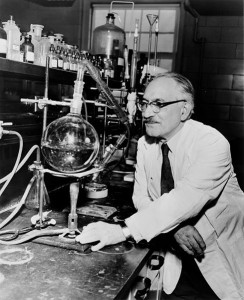
New York World-Telegram and the Sun staff photographer: Higgins, Roger, photographer/ Wikimedia Commons/ Public Domain
Streptomycin was the first antibiotic drug to be discovered that was effective in the treatment of tuberculosis. It was isolated in October 1943 by Albert Schatz, Selman Waksman, and Elizabeth Bugie with Waksman going on to win the Nobel Prize for Medicine in 1952 for his work on the discovery of streptomycin. Extensive human trials of the drug were carried out in the USA in the years following its discovery and the UK’s Medical Research Council (MRC) carried out its first randomised, controlled clinical trial of the drug in 1946. The MRC’s trial aimed to compare the effectiveness of streptomycin combined with bed rest with that of bed rest alone and did eventually show the drug to be more effective.
At this point the drug was used in conjunction with the traditional methods utilised in the sanatoriums, such as bed rest and light treatment, and we start to see cases of streptomycin being used as treatment in Stannington Sanatorium from 1947. Although it was available as an effective treatment and the only drug treatment option it was not widely used on the children of Stannington, and instead particular cases were singled out as suitable candidates for treatment. There were several problems arising from the use of streptomycin that meant it could not be a cure-all treatment for everyone.
The drug must be administered by injection which could prove to be very painful, a particular problem where children were involved. One girl, patient no. 13/1949, had been receiving regular streptomycin treatment at Newcastle General Hospital before being admitted to Stannington. Initially intramuscular and intrathecal treatment was used, which involved administering the drug directly into the muscle and into the membrane of the spinal cord. Daily treatments were continued for 4 weeks and although there were some initial signs of improvement toward the end of the 4 weeks the patient began to become very ill with continuous vomiting, drowsiness, incontinence and papilloedema (swelling of the optic discs caused by intracranial pressure) so treatment had to be stopped. A week after treatment was stopped there was a marked improvement in her general condition and so treatment was resumed with a general anaesthetic being required for each intrathecal injection. The patient continued to improve but the papilloedema persisted and the intrathecal therapy was proving difficult to administer. Instead a tube was inserted along the floor of the skull to the interpeduncular fossa and streptomycin injected on alternate days, which in turn led to the reduction of the papilloedema and improvement in her condition generally. She was continued on intramuscular injections up to her discharge to Stannington Sanatorium where she was to receive more traditional treatment and rest on the basis that she would be returned to NGH if any relapse in her condition was experienced.
This case clearly illustrates how streptomycin was not a simple cure not least because the administration of the drug was particularly uncomfortable but also because of the side-effects that could be experienced. One noted side-effect in children is the possibility of irreversible auditory nerve damage. Contemporary studies also showed that toxic reactions to interthecal streptomycin could occur sometimes with fatal consequences. The invasive methods of administering the drug meant that when it was first introduced some of the children in Stannington Sanatorium that were chosen to receive the treatment had to be discharged to a local hospital to receive it. Nonetheless, it still provided incredibly successful results and patient 13/1949 went on to be discharged as quiescent.
Of the cases from Stannington Sanatorium that received streptomycin treatment we can see that they were all suffering from quite severe forms of tuberculosis making streptomycin a last attempt where it was known that traditional sanatorium methods would not work. For example, the above case, patient 13/1949, was suffering from TB meningitis, which along with miliary TB was responsible for a large number of deaths. Looking at patient files from the beginning of the 1940s we can see that it was these sorts of cases where deaths regularly occurred, whereas most other manifestations of TB responded well to sanatorium treatment. In this respect streptomycin was incredibly successful in treating patients that only a couple of years earlier would most likely have died.
The years following the introduction of streptomycin saw the development of several other drugs effective in the treatment in TB which helped to tackle problems of drug resistance that had been developing. Instead combination therapy using multiple drugs became possible and their proper administration meant that the development of drug-resistant strains could be tackled. Owing to drug resistance and its difficult administration streptomycin is no longer a first line drug but remains on the World Health Organisation’s (WHO) list of essential medicines.
Sources:
SCHATZ, A, BUGIE, E, & WAKSMAN, S. A. (1944) Streptomycin, a substance exhibiting antibiotic activity against gram-positive and gram-negative bacteria, Proceedings of the Society for Experimental Biology and Medicine, 55, pp.66-69.
BYNUM, H. (2012) Spitting Blood: The History of Tuberculosis, Oxford University Press, p.195.
MILLER, F. J. W, SEAL, R. M. E, and TAYLOR, M. D. (1963) Tuberculosis in Children, J & A Churchill Ltd. p.184.

Thank you for this information